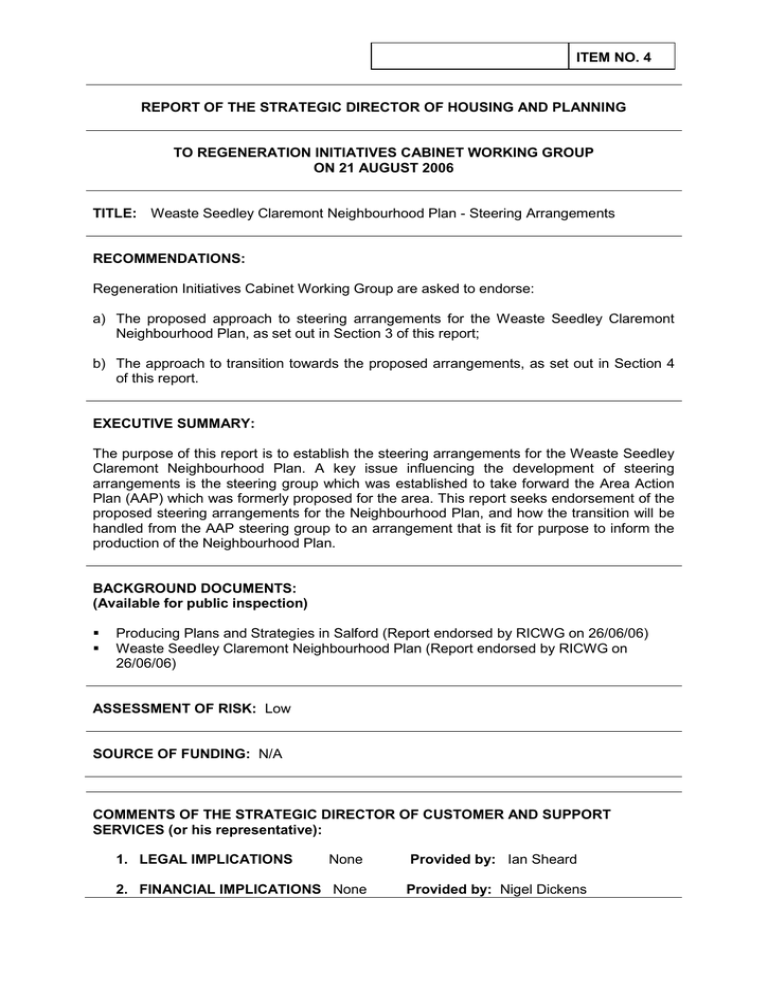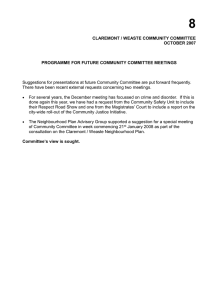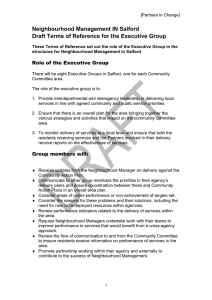ITEM NO. 4 REPORT OF THE STRATEGIC
advertisement

ITEM NO. 4 REPORT OF THE STRATEGIC DIRECTOR OF HOUSING AND PLANNING TO REGENERATION INITIATIVES CABINET WORKING GROUP ON 21 AUGUST 2006 TITLE: Weaste Seedley Claremont Neighbourhood Plan - Steering Arrangements RECOMMENDATIONS: Regeneration Initiatives Cabinet Working Group are asked to endorse: a) The proposed approach to steering arrangements for the Weaste Seedley Claremont Neighbourhood Plan, as set out in Section 3 of this report; b) The approach to transition towards the proposed arrangements, as set out in Section 4 of this report. EXECUTIVE SUMMARY: The purpose of this report is to establish the steering arrangements for the Weaste Seedley Claremont Neighbourhood Plan. A key issue influencing the development of steering arrangements is the steering group which was established to take forward the Area Action Plan (AAP) which was formerly proposed for the area. This report seeks endorsement of the proposed steering arrangements for the Neighbourhood Plan, and how the transition will be handled from the AAP steering group to an arrangement that is fit for purpose to inform the production of the Neighbourhood Plan. BACKGROUND DOCUMENTS: (Available for public inspection) Producing Plans and Strategies in Salford (Report endorsed by RICWG on 26/06/06) Weaste Seedley Claremont Neighbourhood Plan (Report endorsed by RICWG on 26/06/06) ASSESSMENT OF RISK: Low SOURCE OF FUNDING: N/A COMMENTS OF THE STRATEGIC DIRECTOR OF CUSTOMER AND SUPPORT SERVICES (or his representative): 1. LEGAL IMPLICATIONS None 2. FINANCIAL IMPLICATIONS None Provided by: Ian Sheard Provided by: Nigel Dickens PROPERTY: N/A HUMAN RESOURCES: N/A CONTACT OFFICER: Mike Arnold (ext 3646) WARD(S) TO WHICH REPORT RELATE(S): Claremont, and Weaste and Seedley KEY COUNCIL POLICIES: N/A DETAILS: 1 BACKGROUND 1.1 The purpose of this report is to establish the steering arrangements for the Weaste Seedley Claremont Neighbourhood Plan. It was agreed at Cabinet Working Group on 26 June 2006 that the Weaste Seedley Claremont Neighbourhood Plan would act as a pilot for an approach that could be rolled out across the city. 1.2 Discussions are continuing regarding the implications of rolling out Neighbourhood Plans across the city, however it was confirmed at Regeneration Initiatives Officer Working Group on 7 August 2006 that the Weaste Seedley Claremont Neighbourhood Plan should continue to be progressed as a pilot. In order to take this forward, it was agreed that this report be presented to Cabinet Working Group for endorsement. 1.3 In terms of the Weaste Seedley Claremont Neighbourhood Plan, a key issue influencing the development of steering arrangements is the steering group which was established to take forward the Area Action Plan (AAP) which was formerly proposed for the area. 1.4 It is considered that the Neighbourhood Plan will require a different approach to steering arrangements in order to effectively guide its production. This reflects both its status as a non-statutory document and the objective to produce the plan within a timescale of around 12 months. The proposed steering arrangements for the Neighbourhood Plan will comprise an officer group and an advisory group, together with effective stakeholder engagement. 1.5 This report is therefore structured around three key points: a) the AAP steering group and how this was established; b) the proposed steering arrangements for the Neighbourhood Plan; and c) how the transition will be handled from the AAP steering group to an arrangement that is fit for purpose to inform the production of the Neighbourhood Plan. 2 AREA ACTION PLAN STEERING GROUP 2.1 The Weaste Seedley Claremont AAP steering arrangements were modelled on those that had been established to guide the Pendleton AAP. This consisted of an officer group, a steering group, a community forum, and a stakeholder group. In terms of the steering group, its purpose was to guide the process and production of the AAP. Its membership included representation from Central Salford URC, CABE, GMPTE, Greater Manchester Police, New Prospect Housing Ltd, Manchester Methodist Housing Association, Salford PCT and Royal Hospitals NHS Trust, together with representation from a small number of key business interests within the area (see Appendix 1). Membership also included elected ward members together with 5 community representatives. 2.2 The 5 community representatives were selected on to the steering group through a comprehensive selection process. Applications were invited as part of correspondence distributed to all c.10,000 households within the area informing them of an initial community forum workshop. From this 12 applications were received, each submitting evidence for why they considered they met the person specification to sit on the group. A small selection committee was set up comprising of officers, the Chair of the Community Committee, and several community representatives. From this, 5 of the 12 applicants were selected to sit on the steering group. 2.3 The perception is that attendance at the 2 AAP steering group meetings held was relatively poor, particularly in terms of attendance by the partner and stakeholder representation. The last meeting of the group took place in October 2005 and with the AAP not being progressed there has been no further engagement of the group since. 3 NEIGHBOURHOOD PLAN STEERING ARRANGEMENTS 3.1 It is proposed that steering arrangements would comprise of the following: Officer Group - an Officer Group will be established to guide the production of the Neighbourhood Plan. This will comprise representation from across the Council's Directorates. Draft terms of reference for the Officer Group are attached at Appendix 2. Advisory Group - an Advisory Group would be established to inform the production of the Neighbourhood Plan, particularly in terms of securing effective community engagement. It is envisaged that membership would comprise elected members, community representatives and the Neighbourhood Manager. Additional detail on the proposed arrangements for the Advisory Group is set out below. Draft terms of reference for the Advisory Group are attached at Appendix 3. Stakeholder Engagement - a flexible approach will be taken to engage key stakeholders. The identification of key stakeholders will be based around those stakeholders that were formerly part of the AAP Steering Group, i.e. Central Salford URC, GMPTE, Greater Manchester Police, Central Salford ALMO, Salford PCT, Salford Royal Hospitals NHS Trust, together with other key public sector partners and significant business interests within the area. The Officer Group will advise on those stakeholders to be engaged and the optimum approach to engagement. One approach would be to convene a small number of stakeholder meetings at key stages in the process in order to inform the production of the Neighbourhood Plan. It is anticipated that by tailoring a meeting specifically to stakeholders there would be more effective engagement than at the AAP steering group meetings where there was a high degree of non-attendance from stakeholders. Advisory Group 3.2 Discussions have demonstrated general consensus of the need for wider steering arrangements for the Neighbourhood Plan to complement an officer level working group. It is however considered that the Neighbourhood Plan steering arrangements would benefit from being more focused than was the case for the AAP steering group. This in part reflects the nature of the Neighbourhood Plans as more streamlined corporate documents, and also reflects the objective to deliver them within a relatively short timescale of around 12 months. Where the AAP steering group was engaged to steer the process of production, it is envisaged that for the Neighbourhood Plans this role will be undertaken principally at officer level. The purpose of wider steering arrangements for the Neighbourhood Plan is envisaged to be mainly in terms of: a) Acting as an advisory group to inform the production of the Neighbourhood Plan, particularly in terms of securing effective community engagement; b) Acting as a sounding board for ideas and draft documents prior to undertaking wider consultation with the community; and c) Guiding the identification of key areas of focus for the Neighbourhood Plan. 3.3 The group is to be engaged at 5 key stages in the production of the plan (see draft Terms of Reference at Appendix 3). The group will not be engaged to 'sign off' the final document given that the Neighbourhood Plans are corporate documents. Formal approval will be undertaken via the stages of Officer Group / Lead Member / Cabinet and Council. 3.4 It is proposed that the Advisory Group would comprise the following membership: Elected Ward Members All 6 (or less if agreed) Community Representatives 4 Neighbourhood Manager 1 Total (maximum) 11 3.5 When the Neighbourhood Plans approach was previously discussed with Lead Member for Planning, the need to consider boundaries and overlap was raised as a key issue. It is considered that the best means for ensuring that key cross-boundary issues are picked will be via the Officer Group and through stakeholder engagement. The early identification of key cross-boundary issues would enable the tailoring of consultation events to engage communities from surrounding areas where appropriate. This would avoid the need for the Advisory Group membership to include representation from surrounding areas. 4 TRANSITION TO PROPOSED ARRANGEMENTS 4.1 Following the stages of endorsement outlined below, these steps are proposed to handle the transition to the new steering arrangements: a) Write to all members of the former Area Action Plan steering group (as per Appendix 1) to advise them of the Neighbourhood Plan process and new steering arrangements. Given the comprehensive and accountable process that was undertaken to elect the community representatives on to the AAP steering group, the four existing community representatives will be invited to take on this role within the Neighbourhood Plan Advisory Group; b) In the event that any of the four community representatives decline the invitation to sit on the Advisory Group, nominations for additional community representatives will be sought via Community Committee; c) The election of a Chair will need to be considered. The existing AAP Chair could either continue in the role as Chair of the Advisory Group, or alternately it may be more appropriate for the Advisory Group to formally elect a Chair at its first meeting. This is an issue where the advice of Political Executive will be sought. It should be noted that the position of the existing Chair has not been sought on this, as to whether he wishes to continue in his role. 5 CONCLUSION AND RECOMMENDATIONS 5.1 In order to approve the approach, this report will be discussed as follows: a) Include this report on the agenda for Planning Lead Member on 15 August 2006; b) Include this report on the agenda for Regeneration Initiatives Cabinet Working Group on 21 August 2006, and seek endorsement for the approach proposed; c) Include this report on the agenda for the Claremont and Weaste Political Executive (subsequent to RICWG), and seek their advice on the arrangements to Chair the advisory group. 5.2 Regeneration Initiatives Cabinet Working Group are asked to endorse: a) The proposed approach to steering arrangements for the Weaste Seedley Claremont Neighbourhood Plan, as set out in Section 3 of this report; b) The approach to transition towards the proposed arrangements, as set out in Section 4 of this report. APPENDIX 1 FORMER AREA ACTION PLAN STEERING GROUP MEMBERSHIP Jason Syers (Chair) Emma Appleton Clare Pilsworth Lynn Crowder Michael Halsall (formerly Cllr Ferrer) Cllr Geoff Ainsworth Cllr Janice Heywood Cllr John Deas Cllr Mary Ferrer Cllr Norman Owen Cllr Stephen Cooke Rosemary Olle Inspector Alan Smith Peter Bojar Sam Tindale Roger Wheeldon Susan Slater Simon Neville Elaine Wilkinson Professor Brian Robson Community Representative CABE Central Salford URC Community Representative Community Representative Community Representative Community Representative Elected Member Elected Member Elected Member Elected Member Elected Member Elected Member GMPTE Greater Manchester Police Manchester Methodist Housing Association New Prospect Housing Ltd Peel Holdings Salford Primary Care Trust Salford Royal Hospitals NHS Trust The Willows Variety Centre University of Manchester APPENDIX 2 OFFICER GROUP - DRAFT TERMS OF REFERENCE 1 Purpose The purpose of the Weaste Seedley Claremont Neighbourhood Plan Officer Group is to: a) inform and guide the process for production of the Neighbourhood Plan; b) ensure that all stages of the production of the Neighbourhood Plan reflect the Council's key priorities, from across all Directorates; c) review key emerging documents associated with the production of the Neighbourhood Plan to inform their content; d) highlight key cross-boundary linkages where these will need to be addressed by the Neighbourhood Plan, and consultation events tailored accordingly; e) approve the draft Neighbourhood Plan and recommend its approval by Planning Lead Member and Cabinet for the purposes of formal consultation; f) approve the final draft Neighbourhood Plan and recommend its approval by Planning Lead Member, Cabinet and Council for the purposes of formal adoption and publication. 2 Membership Membership of the Officer Group will comprise representation from across the Council's Directorates. A Chair will be identified to guide discussion within the group. Key stakeholders may be invited to attend meetings of the Officer Group, where the Officer Group considers this appropriate. 3 Meetings The Officer Group will be engaged at 6 key stages in the production of the plan: Inception meeting - inform process for production of Neighbourhood Plan, review draft Baseline and Issues Report, inform preparation of brief to consultants, and agree approach to stakeholder engagement; Discuss key areas of focus to inform workshop priorities; Discuss key issues emerging from workshops, and how these will be reflected in the draft plan; Review first draft Neighbourhood Plan; Review draft Neighbourhood Plan prior to formal consultation and recommend its approval by Planning Lead Member and Cabinet; and Review final draft Neighbourhood Plan and recommend its approval by Planning Lead Member, Cabinet and Council for the purposes of formal adoption and publication. 4 Conduct of Meetings Normal rules of conduct will apply: Agendas will be published and distributed in advance of the meeting. A note of each meeting will be prepared highlighting the key issues raised and actions. APPENDIX 3 ADVISORY GROUP - DRAFT TERMS OF REFERENCE 1 Purpose The purpose of the Weaste Seedley Claremont Neighbourhood Plan Advisory Group is to: a) act as an advisory group to inform the production of the Neighbourhood Plan, particularly in terms of securing effective community engagement; b) act as a sounding board for ideas and draft documents prior to wider consultation being undertaken with the community; and c) guide the identification of key areas of focus for the Neighbourhood Plan. 2 Membership Membership of the Advisory Group will comprise: Elected Ward Members All 6 (or less if agreed) Community Representatives 4 Neighbourhood Manager 1 Total (maximum) 11 Key officers involved in the production of the Neighbourhood Plan will attend the Advisory Group meetings as appropriate. The Advisory Group will elect a Chair. 3 Meetings The Advisory Group will be engaged at 5 key stages in the production of the plan: Inception meeting - review draft Baseline and Issues Report and inform preparation of brief to consultants; Inform approach to community engagement, including workshop priorities and areas of focus; Discuss key issues emerging from workshops, and how these will be reflected in the draft plan; Review draft Neighbourhood Plan prior to formal consultation; and Discussion of key issues emerging from formal consultation, and how the plan will be updated to reflect these. Meetings will not be open to the public. 4 Conduct of Meetings Normal rules of conduct will apply: 5 The Chair will assume overall responsibility for ensuring the conduct of the meeting. Members of the group will contribute in a positive and objective manner and will respect the views of others. No member of the group will represent a particular interest or lobby group. Any pecuniary, non-pecuniary or conflict of interest must be declared during the meeting and the appropriate course of action taken. Agendas will be published and distributed in advance of the meeting of the group. A note of each meeting will be prepared highlighting the key issues raised and actions. Confidentiality Members of the group can communicate with the public or the press where agreed by the group. Discussion that is deemed confidential by the group must not be communicated. Certain information distributed at meetings might not be appropriate to be disclosed further until it has been subject to relevant stages of Council approval.




